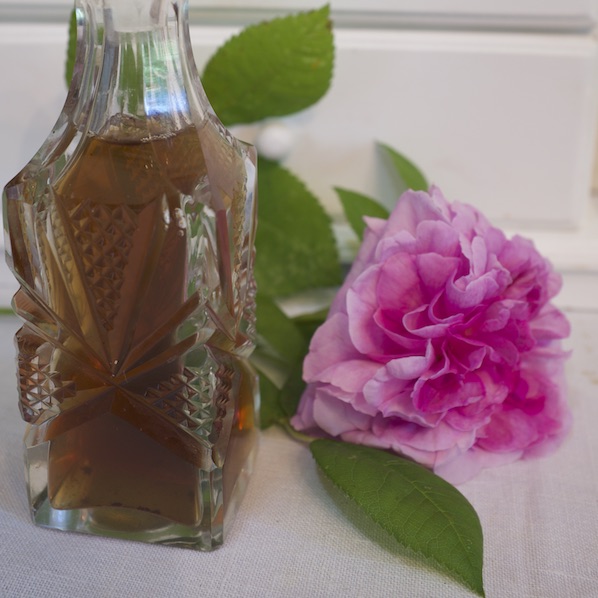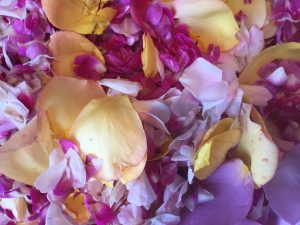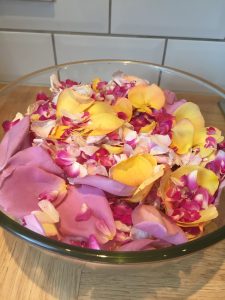
The Essential Guide to making your own Rosewater
Rosewater is a fundamental in skincare, as an ingredient it crops up in many blend it yourself recipes and it can be used on its own when cleansing, toning, bathing and refreshing. It’s even a calming and restorative cure for a headache.
So rosewater is a staple for year round use. But roses are typically blooming at their best in June.

Here you’ll discover how to use those June blooms to make a rosewater that’s robust enough to remain fragrant throughout the year. And options for storing your rosewater to ensure you have year long supplies.
Fragrant rosewater
While all roses are beautiful to look at, you may notice some have more fragrance than others. And the perfume can change from rose to rose.
In Britain there are 5 native species of wild rose, each bearing a bloom of a different scent:
- The Dog Rose (Rosa Canina) is fruity
- The Wild Musk Rose or Field Rose (Rosa Arvensis) has a deep musky scent
- Sweetbriar, otherwise known as Eglantine (Rosa rubiginosa) is sweet scented and fruity
- The small-leaved Sweetbriar (Rosa micrantha) has a fruity lemony scent
- The Burnet Rose, otherwise known as Scottish Rose (Rosa pimpinellifolia syn Rosa spinosissima) has a delicate, fruity scent.

Rosa gallica
Rosa gallica is the species to use in making skincare products. It’s known as the apothecary’s rose. These flowers have a strong and lasting fragrance that will endure whether the petals are used fresh or dried.
Make your own rosewater
Prepare your rose petals
Aim to collect a good basketful of rose petals. A good quantity would weigh about ½ kg (or 1 lb). These can come from a variety of plants, in fact there may be some benefit in combining gatherings from several bushes. It doesn’t matter what colour the petals are, though some prefer the slightly pinky hue that is created by selecting petals from the deeper end of the red spectrum.
Treat your petals gently while separating them, discarding any stamens, stems and leaves. Ensure your plant material is bug free and in the best possible condition.
If you are planning to dry rose petals for later use, this is the time to lay them on racks with plenty of air circulating. Turn them occasionally as they naturally dry over a few days. I love the aroma in my drying shed when the rose petals are laid out.
For rosewater making, there is no need to dry the petals. Use them as fresh as possible.
Three methods
Here are three methods for creating your rose water using different techniques. The first two use condensation, this is the more traditional method but does require careful set up. The third method uses infusion and needs very basic equipment to achieve. If you like experimenting, try making a batch using each of the methods to know what you prefer.
1. Distilled rosewater – kettle method
Begin by weighing your petals. Whatever weight of petals you have, measure out the same weight of water.
Put the rose petals into a large kettle and cover with the water. Attach a rubber tube to the spout of the kettle and pass this tube through a bowl of iced water. Position a clean jar at a lower level than the kettle and put the rubber tube into the top of the jar.
Then you’re ready to put the kettle over a low heat and allow the water to boil slowly.
Once the water has reached boiling point, steam will pass through the rubber tube. As this flows through the ice bowl it will turn to water which will then drip out of the tube into the jar. This process produces a pure water impregnated with the scent of rose.
Keep a gentle heat under the kettle until all the water has evaporated. You may need to refill the ice bowl during the process to keep it sufficiently cold.
Once complete, take the jar of distilled rosewater and carefully decant it into smaller bottles that can be fitted with a tight lid. Label these and store them (as detailed below).
2. Distilled water – pan and bowl method
For this method you’ll need a saucepan with a close fitting lid and a heatproof bowl that will fit easily within the pan.
Start by putting the bowl in the centre of the pan and then pack the rose petals around the outside of the bowl (leaving the bowl empty). Next pour the water over the rosepetals (being sure that none goes into the bowl).
Place the lid on the saucepan upside-down (so it forms a concave surface). If you’re well-prepared you can put the saucepan lid in the freezer for an hour beforehand to ensure it starts very cold. Place a bag of ice cubes onto the lid (or I used freezer blocks that could be replenished).
Now put a gentle heat under the pan. As the water warms it will create steam which rises, hitting the cold lid of the pan and condensing. The water droplets will then fall into your bowl. Keep the process going until there is more water in the bowl than on the rose petals.
Once complete, leave everything to cool down and then transfer your rosewater into bottles and seal.
3. Infused rose water
Once again, begin by weighing your petals. Whatever weight of petals you have, measure out the same weight of water.
Next place half your total weight of rose petals into a large pan. At this stage you can bruise them slightly using a wooden spoon or the end of a wooden rolling pin. Then cover them with all the water you have just weighed out.
Gently bring the water to the boil and then turn down to simmer, cover tightly and leave simmering for 30 minutes before turning off the heat, and leaving the pan to cool down.
Once cool, strain the petals from the infused water being careful to save all the water. At this stage it is fine to use a sieve as there will be opportunity to ensure all the plant material is removed later.
Next, put the reserved rose petals into the pan (the half of the batch you weighed earlier that didn’t go into the pan first time round) and bruise as before. Cover these with the already-infused water. Now repeat the heating, covering, simmering for 30 minutes and cooling.
Taking the time to do this two-step infusion process makes your rosewater much stronger and likely to retain its scent through the year.
Strain your rosewater very carefully, being sure to remove all plant material. You can begin using a sieve but then repeat the straining using a fine mesh – a good tea strainer or muslin cloth generally works well. Any plant material left in the rosewater has the potential to encourage bacteria and severely limit the life of your beautifully crafted product.
When all is clear, transfer your rosewater to its sterilised storage vessel(s).
Storing your rosewater
It is best to use multiple small storage vessels rather than one large one. That way you can keep unused product sealed and protected. Stored well, your rosewater should last for a year, until the roses bloom again and you can make fresh supplies.
Either, use bottles or jars with tightly sealed lids or, pour your rosewater into small containers that are suitable for freezing (ice cube trays are ideal). You can then keep the frozen rosewater in the original container or un-mould and store cubes of rosewater in a larger container. These can then be brought out individually and defrosted for use.
Long term storage
For longer term storage the best option is freezing in small batches that can be individually defrosted ready for use.
If you don’t have access to freezer space or suitable vessels for freezing, you can store your rosewater in tightly sealed bottles or jars. Ideally these should be dark in colour (you can paint the outside, put a dark sleeve around them or place them in a dark bag or box). Fill to the top then seal tightly and label with as much detail as possible.
Your rosewater label can contain details such as:
- The variety of rose
- Location of gathering or making
- Date the petals were gathered
- Date the rosewater was made
- Who made it
- The process used
- Your anticipated best before date (which will be up to a year, depending on storage conditions)
- You can also include recommendations on how to use the rosewater
For the rosewater you’re using right now
Store your rosewater in a dark, well sealed bottle or jar in a cool place, ideally in the fridge. It’s possible to get small fridges designed specifically for bathrooms to contain fresh beauty products.
You may also want to have your most immediate supplies accessible on a dressing table or in the bathroom, perhaps in a beautiful bottle (a spray top is often a good idea, depending on how you’re using your rosewater). If this is the case, keep the smallest practical quantity in this way and ensure the storage vessel is easy to clean. Make regular refills (if necessary discarding the remnants in preference for fresh rosewater) and clean thoroughly (with boiling water to sterilise) between each refill.
Made and stored with care, you should be able to keep yourself supplied with fragrant rosewater throughout the year.
Now, how are you going to use it? ….
Do share your favourite recipes that make use of rosewater. And click here to know my simplest favourite application of this wonderful skincare ingredient.








[…] easy to make your own, but do be careful to store it well to have availability all year round. Here is a blog telling you exactly how to make your own […]